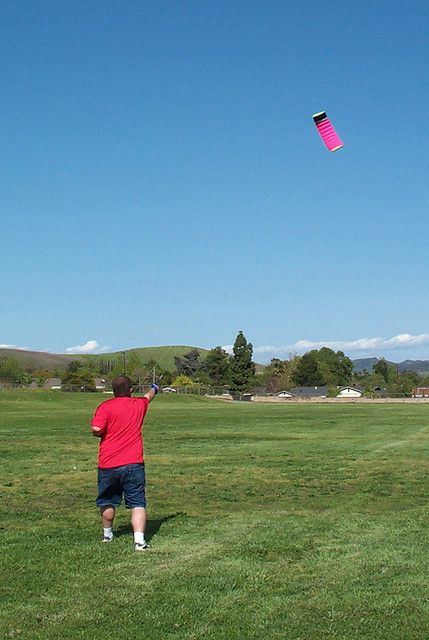- Home Page
- Power Kites
- Kite Safety
Power Kite Safety
For Stunt Flying and Traction
Are you a power-kite beginner and wondering about kite safety? The following bunch of tips should give you a feel for the relevant safety issues. For this page, I'll use the term power kite to mean any flexible kite used for stunt flying or traction.
By stunt flying I mean making the kite fly big shapes in the air while you stand still and control it. In the case of traction, that means the kite is pulling you along. For example, you might be in a buggy over sand or on a surfboard in the ocean.
On this site, there's more kite-making info than you can poke a stick at. :-)
Want to know the most convenient way of using it all?
The Big MBK E-book Bundle is a collection of downloads—printable PDF files which provide step-by-step instructions for many kites large and small.
Every kite in every MBK series.
Kite Safety Hints
The old saying still holds true: "When in doubt, read the instructions!" Kite safety is no exception. Look for a sticker on the packaging or a printed slip which gives kite-safety warnings and flying tips. It's definitely worth spending a few moments to read.
 Photo courtesy of Mike Ivy
Photo courtesy of Mike IvyIt's a great idea to start flying a new kite in fairly light winds, until you are used to it. That way you'll feel more in control when you take the kite out in stronger or gustier conditions. This could apply to stunt or traction kiting. You might even decide to get a small trainer kite first, to have a bit of fun and get the hang of flying a parafoil in a range of conditions.
Choose the right kite, not too big for the wind conditions you expect to fly it in. Whether shopping on or offline, it's easy to get advice on this point. Apart from asking the shop owner, you can just hang out in a relevant forum online to get some answers. Kitesurfing-safety advice is easy to come by, this way. Forums where you can find land kiteboarding safety advice or advice for stunt flying might be a little harder to find.
I can remember seeing a news article where a young guy went out stunt flying with a large power kite—in a gale! He got picked up by a gust and dumped many meters away and was fortunate to survive.
This kite-safety issue is just common sense, really. Fly your new kite in a large enough area, away from obstacles, including other people. In the case of stunt flying, imagine the full extent that the kite might arc to the left or right. Make sure there's nothing there but flat ground.
Can you imagine someone getting whacked in the ear by a fast power kite? I've actually seen a friend after he got hit in the side of his head by a delta stunt kite—there was blood and bruising. Talking about speed, I've read about a Flexifoil Stacker that was claimed to have hit 160 kph! Is that fast or what.
Wear safety gear if you are getting dragged over the ground, for example in buggying. Protect yourself from getting scratched and bruised when you come unstuck in a fresh breeze. Maybe a bush leaped out and got you. Or perhaps you didn't react quick enough to a big gust and you ended up sliding across gravel.
On the topic of kite safety gear, a helmet is sometimes recommended for kite surfing in the ocean. Most images you see on the Web show people kite surfing without helmets, but in strong conditions it's possible to hit the water hard. At high speed, water isn't soft anymore, and it is possible to get injured. Some kiting helmets are pretty minimal and don't look anything like motorcycle helmets and yet offer useful protection. Of course, when traveling over hard ground, that's an even better reason to use a helmet!
If you use a kite harness, a safety release system allows you to detach from the kite in an emergency—for example, if you are about to hit a hard object. Or maybe a huge gust is threatening to turn you into an unwilling paraglider pilot! Also, if you are using a fully-depowerable kite, it's quicker to just drop the bar and get out of trouble that way.
Think about getting kite instruction before getting into the more advanced extreme sports. It costs a bit but results in fewer hassles and a smoother entry to the thrills of traction kiting. Actually, by being less likely to damage your kite, you might even save a bit of money in the long run!
Otherwise, if going it alone without any kite lesson, get good at doing stunts with your power kite before thinking about letting it drag you along. Try doing one thing at a time! Be a stunt pilot first, then a kiteboarding hero later.
As mentioned earlier, there's more kite making on this site than you can poke a stick at. :-)
Want to know the most convenient way of using it all?
The Big MBK E-book Bundle is a collection of downloads—printable PDF files that provide step-by-step instructions for many kites large and small.
That's every kite in every MBK series.
